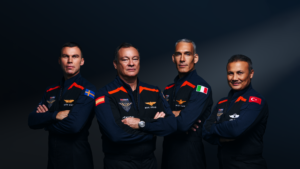Axiom-3 Home at Last
The four-person Axiom-3 private astronaut crew is home at last, days late because of poor weather in Florida. Their ride to and from the International Space Station was aboard a SpaceX Crew Dragon capsule that splashes down either in the Atlantic Ocean or Gulf of Mexico off the Florida coast. Rough seas meant they spent almost a week longer in space than expected. The mission included Türkiye’s first astronaut, ESA’s first “project astronaut,” and the first Italian astronaut to make a suborbital spaceflight before visiting the ISS.
Mission commander Michael López-Alegria, a former NASA astronaut who now works for Axiom, splashed down near Daytona, FL at 8:30 am ET with his companions Walter Villadei (Italy), Alper Gezeravci (Türkiye) and Marcus Wandt (Sweden/ESA). [Video from @Axiom_Space on X]
Welcome back to Earth, #Ax3 Crew: @CommanderMLA, @WalterVilladei, @TURKastro, and @astro_marcus. Today, the Dragon spacecraft successfully splashed down, marking the end of their successful mission to the International Space Station. pic.twitter.com/vqaeyOmT87
— Axiom Space (@Axiom_Space) February 9, 2024
This is López-Alegria’s second mission for Axiom (he flew on four NASA flights previously) and like the first, Axiom-1, their return was delayed because of the weather.
Launched on January 18 at 4:47 pm ET, they expected a 16-day mission, with 14 of them on ISS. They docked to ISS early on January 20, planning to undock on February 3 and land the next day. Bad weather in Florida delayed undocking to February 7, giving them four more days aboard the ISS. Then they remained in orbit inside Crew Dragon for another 47 hours until their orbital path lined up with their splashdown site. In all, the mission ended 21 days and almost 15 hours after liftoff, approximately 6 days longer than anticipated.

Villadei, Gezeravci and Wandt were on their first trips to orbit, although Villadei made a suborbital trip on Virgin Galactic’s SpaceShipTwo last summer so this was his second time in space. All three are military pilots for their governments. Several Italians and one other Swede have made spaceflights, but Gezeravci is Türkiye’s first astronaut. His flight comes during the 100th anniversary of the founding of Türkiye. López-Alegria holds dual citizenship in Spain and the United States, so Axiom calls this the first all-European space crew. [Video posted by @SpaceX on X.]
The Ax-3 crew waving hello as Dragon’s hatch opens pic.twitter.com/jXJTMmlrxr
— SpaceX (@SpaceX) February 9, 2024
Wandt was selected as a reserve astronaut for the European Space Agency last year. ESA is one of the partners in the ISS and gets to fly its astronauts as part of regular crew rotations. Rather than waiting for one of those opportunities, however, some ESA members like Sweden now are opting to pay ESA extra to arrange to fly their astronauts on a private astronaut mission. ESA calls Wandt a “project astronaut” since his flight is a one-time contract, not employment as part of the ESA astronaut corps. Wandt is ESA’s first project astronaut, but not the last. A Polish astronaut may be next. Axiom-4 is expected to launch this fall, but the crew members have not been officially announced yet.
Axiom-3 is the third private astronaut flight by Axiom Space, a company that plans to build a commercial space station to succeed the ISS. Their modules will dock first with the ISS and later separate to become a free-flying space station. For now, they are launching paying customers to spend time on the ISS conducting experiments and enjoying life in microgravity. Axiom views these flights as precursors to their own space station operations. Mike Suffredini, a former NASA ISS program manager, is CEO of Axiom. The House Science, Space, and Technology Committee will hold a hearing next week on the future of the ISS and commercial space stations.

Axiom pays SpaceX for transportation to and from the ISS and NASA for use of ISS. The price Axiom charges per customer has not been divulged, but is thought to be on the order of $55 million.
López-Alegria and another record-holding former NASA astronaut, Peggy Whitson, joined Axiom and command these missions to the ISS. Both served as ISS commanders during their time at NASA (Whitson did it twice), so are intimately familiar with the facility and can provide real-time assistance to their passengers.
Crew Dragon is typically outfitted with four seats, so three are available for passengers. So far they’ve been a mix of wealthy “tourists” and government astronauts from a variety of countries.
This mission carried three government military pilots. Because the arrangements are made through Axiom, a private company, they nonetheless are called private astronauts or commercial astronauts even though they were sponsored by their governments.
Non-professional astronauts willing to pay Russia substantial sums have visited the ISS since 2001. These “space tourists” travelled on Russian Soyuz spacecraft and stayed primarily in the Russian segment. It took almost two more decades for NASA to embrace the idea, but in 2019 established a pricing plan for visitors to the U.S. segment. The first U.S. private astronaut mission to the ISS was Axiom-1 in April 2022.
SpaceX launches its own private astronaut missions that do not visit the ISS. The first was Inspiration4 in 2021 and more are in the works both on Crew Dragon and SpaceX’s new Starship, which is still in development. Crew Dragon can only travel to Earth orbit, but Starship is designed to journey as far as Mars. Passengers already have booked circumlunar flights on Starship.
Individuals can make less demanding suborbital flights on Virgin Galactic’s SpaceShipTwo or Blue Origin’s New Shepard where they are in space for only a few minutes.
User Comments
SpacePolicyOnline.com has the right (but not the obligation) to monitor the comments and to remove any materials it deems inappropriate. We do not post comments that include links to other websites since we have no control over that content nor can we verify the security of such links.